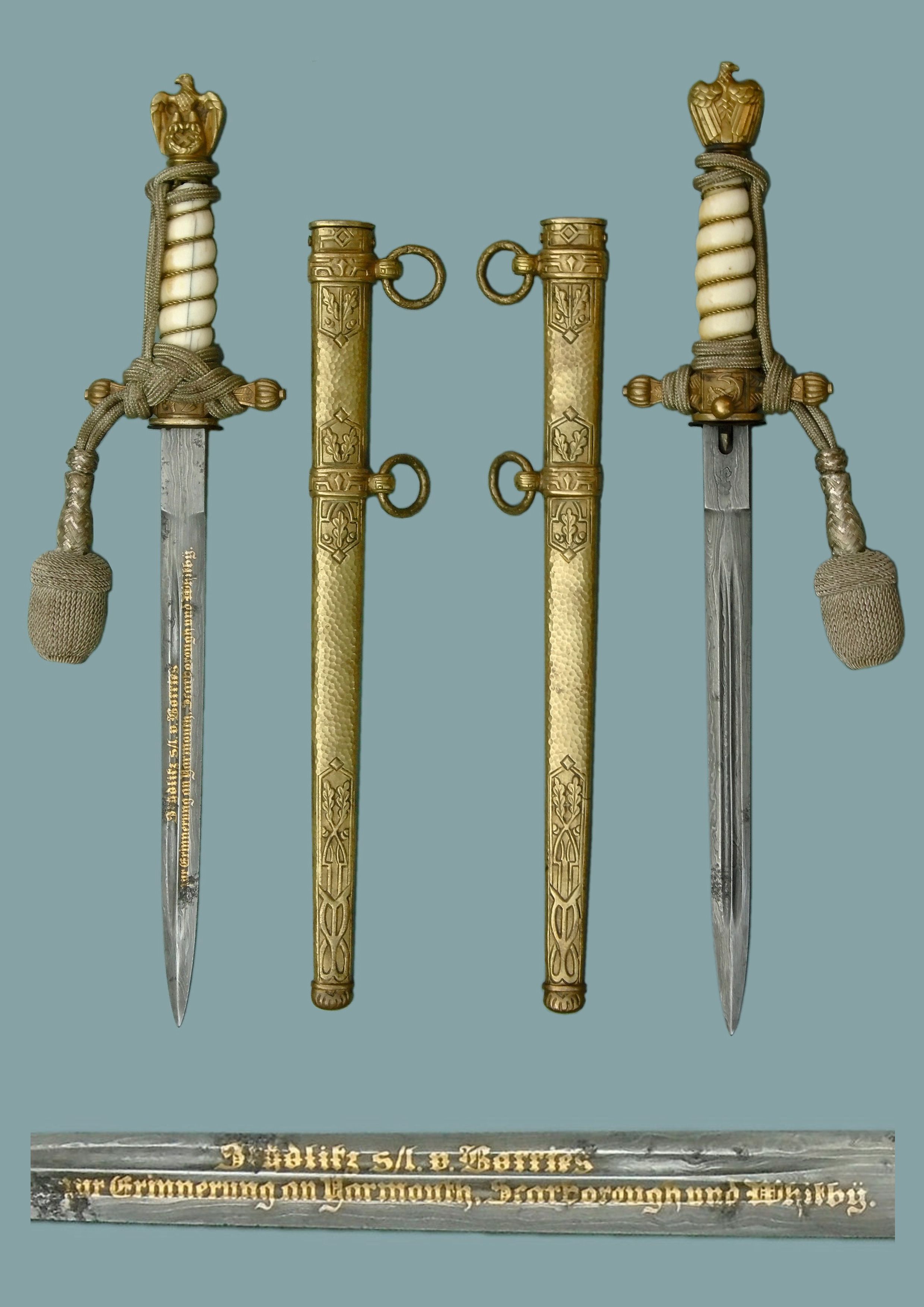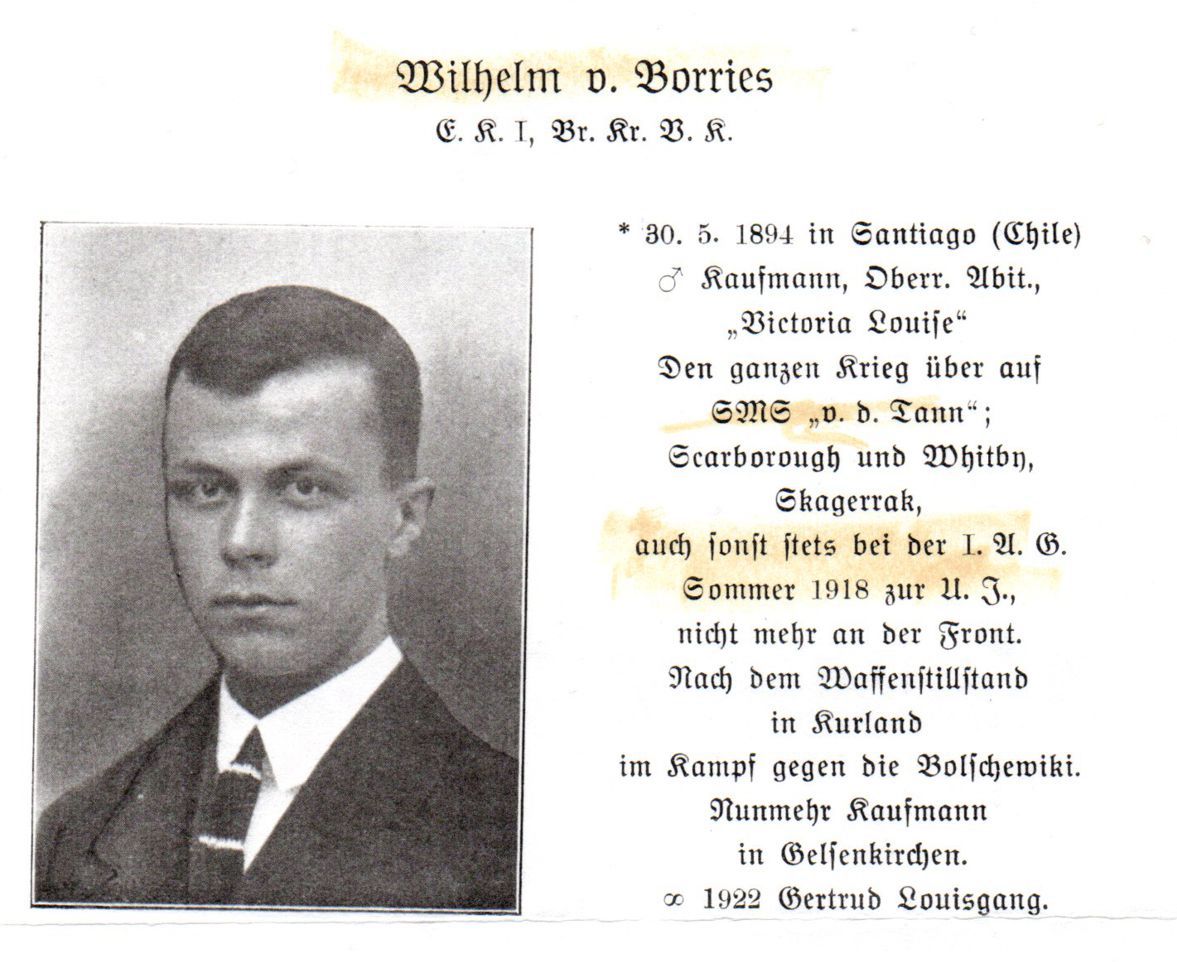In the wake of the German bombardment of the Scarborough on 16 December 1914, the reaction to the dramatic events understandably differed in the two countries involved. Whilst in Britain the popular press and politicians denounced the attack as barbaric, with Winston Churchill branding the Germans as ‘baby killers’, in Germany the bombardment was celebrated as an audacious attack beneath the noses of the all-powerful Royal Navy.
Twenty-five years after the bombardment, a dagger, engraved with the names of three British towns bombarded in November and December of 1914 (Yarmouth, Scarborough and Whitby) was produced. The dagger is highly elaborate, the blade being made of Damascus steel, trademarked with the Knights Head emblem of its makers, Weyersberg, Kirschbaum & Co, of Solingen; the renowned "City of Blades", a centre of the manufacturing of fine swords, knives, scissors and razors. The white grip of the dagger being fashioned from elephant ivory.
The former owner of the dagger, Frederick J. Stephens of Scarborough, has collected and studied German daggers for six decades. He became aware of the dagger when an advertisement was placed in a military magazine highlighting a sale at Ratisbon auction house in Germany in 2017. He purchased the dagger directly from the auction house, after it failed to reach its reserve. Mr Stephens takes up the story:
When the dagger arrived, I studied it intensely, and was pleased to note that everything about it met the criteria of manufacture and construction in terms of period authenticity. And of course the reason I was so enthused about this dagger, is because I live in the area where the attack on Scarborough took place.
This actual dagger under review is a de-luxe quality Kriegsmarine dagger Model 1938. This being a variation of the earlier pattern Model 1892 Imperial Naval dagger. The original form Model 1892 dagger was rather large - the blade length being about 35cm (13 1/2 inches); and overall length in scabbard being about 50cm (18 inches approx.). The later period dagger Model 1938 was notably smaller than the original Model 1892 - the Model 1938 having a blade length of 25cm (10 inches), and a complete length overall, in scabbard, of 42cm (16 1/4 inches).
There are distinctive features on the pommel, and the cross guard which suggest that this dagger was manufactured at a notably later period than the original December 1914 occasion of the attack on Scarborough. The blade of the dagger is made of Damascus steel, and is distinctive with its etched dedication commemorating the Scarborough, Yarmouth, and Whitby attack.
Another important feature is the form the WKC trademark as stamped into the blade. The WKC company, known more formally as Weyersberg Kirschbaum & Cie, of Solingen, was a well established manufacturer of swords and daggers. The origins of the company can be traced back to 1883 when it was formed through the amalgamation of two existing companies, Gebr. Weyersberg and W. R. Kirschbaum & Co. A trademark for the company, featuring the emblems of a King's Head and a Knight's Head in armour together with the letters WK&C was registered, and is sometimes found stamped on WWI period pieces produced by the company.
Following the end of the War of 1914-1918, the establishment of the Treaty of Versailles, and Occupation within Germany, very many of the German weapons manufacturers went out of business in the Commercial Depression which followed. The WKC company was one such business which lost its commercial markets during the Depression, and the company was declared insolvent and ceased trading.
In 1930 the ownership of the old WKC succeeded in re-financing themselves and re-registered the company under the new name of WKC Waffenfabrik GmbH, and registered a new version of the company trademark. The new emblem was the singular feature of a Knight's Head in armour - slightly different in style to the former King's Head and Knight's Head emblem.
It is usage of this new version of the trademark on the blade of the von Borries dagger that convinces me that this piece was not made during World War One, but was in fact manufactured after 1930; and more specifically the fact that it features the eagle and swastika pommel (introduced in 1938 for the German Naval dagger) suggests to me that it was created in the latter part of the 1930s.
As this period of production would be clearly more than to decades since the events of the Scarborough Bombardment, I suspect that the creation of this dagger is commemorating the 25th Anniversary of that notable event.
If the dagger was produced in the late 1930s, as the evidence forwarded by Frederick J. Stephens suggests, it was more than likely presented in December 1939, to commemorate the 25th anniversary of the bombardment. As a new world war had broken out by that date, it could be interpreted as a call to arms, by remembering the attack on the British mainland, it might inspire those about to embark on a new conflict with the Royal Navy.
The eminent German naval historian Dr. Jann M. Witt researched the German officers involved in the manufacture and gifting of the dagger. Both men served on board the battlecruiser Von Der Tann during the raid on Scarborough and Whitby.
Herbert Seydlitz: the man who gifted the dagger
The man who gifted the dagger was officer candidate Herbert Seydlitz, who served on board the battlecruiser Von Der Tann during the attack on Scarborough. He was born on 11 September 1896 and joined the Imperial German Navy in April 1914. He was later transferred to the Brummer, a minelaying light cruiser, where he was promoted to Leutnant zur See (Midshipman) in October 1917. He then transferred to the U-Bootschule (submarine training centre), but the war ended before he saw active service as a U-boat officer. He left the navy on 28 February 1919 and on 16 January 1921 received an honorary promotion to Oberleutnant zur See (Sub-Lieutenant). It seems that Herbert Seydlitz did not serve during World War Two.
Wilhelm von Borries: the recipient of the dagger
The recipient of the dagger was Wilhelm von Borries. He was born on 30 May 1894 and joined the Imperial German Navy in April 1914. During the First World War he served on the same battlecruiser as Herbert Seydlitz, Von Der Tann, as a cadet and acting officer until his promotion to Midshipman in October 1918.
From September to November 1915 he had attended a radio training course and from June 1915 to September 1916 a navigation training course. He saw action on board the Von Der Tann at the Battle of Jutland on 31 May 1916. Von Der Tann, was heavily engaged, she was credited with sinking the British battlecruiser HMS Indefatigable during the famous ‘run to the south’ element of the battle. As the battle progressed Von Der Tann was badly damaged by hits from Barham, Tiger and Revenge. Nevertheless, Von Der Tann survived the punishment, but required two months of repairs to bring her back into frontline service.
In October 1918 von Borries was transferred to the U-Boat training centre, where he remained until the end of war. He was discharged on 10 November 1919, but received honorary promotion to Sub Lieutenant on 13 April 1921. It is probable that von Borries served in the Kriegsmarine during World War Two, but thus far research has been unable to fully confirm this. Wilhelm von Borries died on 9 August 1970.
Conclusion
As noted it is highly probable that the dagger examined in this article was the only one produced to commemorate the German raid on Scarborough and Whitby in December 1914. Of course, for the civilians in Scarborough and Whitby, the attack was one that brought death and destruction to the almost completely undefended towns. However, for the crews on board the German ships, the raid would have been one of the highlights of the war. A mixture of excitement and fear would have undoubtedly been felt by the German sailors as they attacked the British mainland. A counterattack by a vengeful Royal Navy would have been uppermost in the minds of everyone on board the battlecruisers and light cruisers involved in the operation.
The bond that existed between the giver of the dagger, Herbert Seydlitz, and its recipient, Wilhelm von Borries, would have surely been deepened by their shared experience on board Von Der Tann during the bombardment of Scarborough. The dagger can be interpreted as a physical representation of comradeship forged during one of the iconic moments of the Great War at sea; the attack on Scarborough and Whitby on 16 December 1914.
This article was researched and written collaboratively by: Richard Hudson, Dr David Pendleton, Frederick J. Stephens and Dr Jann M. Witt

